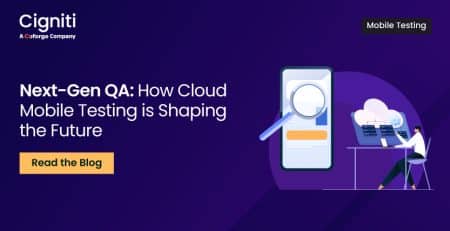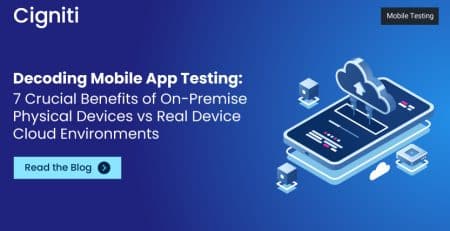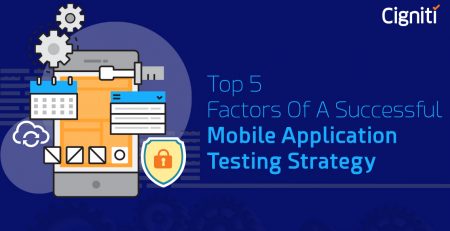Mobile labs for continuous integration testing
|
Listen on the go!
|
In terms of release pace, testing maturity, and tools, mobile applications have generally lagged behind their web equivalents.
In today’s interconnected environment, however, mobile is driving most of the innovation. Mobile phones and software have become an intrinsic part of our daily lives.
It’s no surprise that today’s software development is driven by a mobile-first imperative, even if it’s not mobile-only.
Despite these significant advancements, developers continue to face challenges when it comes to mobile testing.
Using a cloud-based mobile device lab is the ideal method to simplify infrastructure, device maintenance, and continuous integration testing.
Mobile labs or device centers offer a wide selection of cross-platform mobile devices to software testing teams (Android, iOS, Windows). Essentially, it allows both manual and automated application testing in real-world scenarios.
With the mobile industry’s ever-changing trends, enterprises must guarantee that their apps are compatible with the most recent devices. Developers and testers will need access to a variety of the most recent cross-platform (Android, iOS) devices to test their apps.
Real-world testing yields accurate test results and aids in the detection of faults that an end-user would face in real-world use. As a result, developers and testers like to have access to Mobile Testing Labs in order to deliver sturdy apps with excellent user experiences.
The most accurate type of test equipment is a real device. Your users are utilizing real devices, presumably the same ones that you have accessible for human or automated testing.
Nothing beats reproducing user-reported bugs on the same devices that the users were having issues with. Costs are reduced and procurement difficulties are eliminated with a cloud-based actual device lab.
Key considerations while creating a Mobile Testing laboratory
Market changes in the mobile business must be monitored by teams and organizations. They must conduct market research and select mobile devices with OEMs, OS versions, and screen resolutions that are popular among their target audience.
When the number of devices on a Wi-Fi network grows, challenges arise when they all need to communicate data at the same time. Because most Wi-Fi access points aren’t designed to handle such high bandwidth, users are likely to experience a variety of server response timeouts.
Because time is of the importance when it comes to software deployment, each mobile testing lab must have an automated app testing infrastructure. This speeds up testing, increases test coverage, and allows for faster bug resolution.
If teams decide to test on-premise device laboratories, they or the organization must invest time and money in procuring, maintaining, and updating devices on a regular basis.
If this isn’t possible, organizations can use a remote device lab, which provides them with a large test infrastructure that is updated on a regular basis. As a result, testers get access to the most up-to-date equipment without having to maintain or update it.
They simply buy a plan, log in, select the appropriate devices, and begin testing. Users can use the remote device lab from anywhere in the office or outdoors.
Organizations can test on a variety of mobile phones and tablets that run on different platforms using remote mobile testing labs (Android, iOS, etc.). This allows companies to test their apps in a variety of scenarios. Because automated testing is possible in remote mobile testing laboratories, testers can deploy bug-free apps faster.
According to Sid Nag, research vice president at Gartner, “Cloud services are definitely shaking up the industry. At Gartner, we know of no vendor or service provider today whose business model offerings and revenue growth are not influenced by the increasing adoption of cloud-first strategies in organizations. What we see now is only the beginning, though. Through 2022, Gartner projects the market size and growth of the cloud services industry at nearly three time the growth of overall IT services.”
More organizations are opting for cloud-based mobile testing labs due to the cost-effectiveness and flexibility provided by this kind of testing.
A reliable cloud-based mobile testing lab should have maximum compatibility with a test infrastructure aimed for full manual and automated app testing. Developers and testers can select from a variety of real mobile phones, tablets, and desktop computers that run on different platforms (Android, iOS, Windows, macOS, etc.).
The cloud is also kept up to speed with the latest and most popular Android and iOS devices from companies like OnePlus, Samsung, Google, Apple, and others.
It also has integrations with Jira, Trello, and Slack, which are all prominent bug-reporting systems. This allows testers to successfully shorten their test cycles, connect with other team members, and deploy apps to the market faster.
There are numerous advantages to having a mobile device lab. It can be used to replicate testing, run programs quickly, replicate performance, and handle device fragmentation, among other things.
Benefits of a mobile device lab
A cloud-based mobile App testing strategy could be a viable and feasible solution for businesses.
Cloud-based testing provides organizations with end-to-end control over human and automated testing methods by offering web-based access to a vast pool of genuine handsets and devices connected to live networks all over the world.
A device lab contains specific hardware that has been fine-tuned by the manufacturer to run apps as quickly as possible. When apps and automation software are run on real devices, both app and automation software performance usually improves.
Real devices are ideal for performing performance testing because they have their own CPUs, GPUs, and other hardware components.
Because virtual devices run virtualized system instructions or on a host OS, they can only provide a relative perspective of program performance.
Even so, relative reports must be carefully examined because system events occurring outside of the virtual device can have an impact on its operation. Even in modest amounts, performance data obtained from real devices is useful since it reflects your consumers’ experiences.
The easiest way to solve device fragmentation across a company’s user base is to use a real device lab. The number of different mobile devices utilized by your clients, especially on Android, might easily be in the dozens.
Using a device lab with numerous devices and OS versions will help ensure that the company’s target customers are properly covered.
Using a cloud-based mobile device lab is the most efficient and effective solution to reduce the complexity of mobile testing. This is a tried-and-true method for lowering costs and expanding coverage across the mobile environment.
Because mobile software has become such a significant engine of innovation, it is now more critical than ever to test it thoroughly.
This is why mobile app testing should be done on a continuous basis.
Almost every online company now has a smartphone app. For some businesses, the mobile app is the first or only channel via which they communicate with new and existing clients.
Continuous Integration (CI) and Continuous Delivery (CD) standards must be followed to streamline regular app changes.
Today, many software businesses use CI/CD to rapidly produce high-quality products.
The CI/CD pipeline technique arose from a trend among today’s software customers to be less and less tolerant of mistakes while also expecting rapid updates and fixes.
Building a CI/CD pipeline, on the other hand, can be difficult. Without the correct automation strategy and technologies, you won’t be able to achieve CI/CD.
Factors to consider while choosing the right CI/CD tools
Because the goal of CI/CD is to deliver quality at a rapid pace in an agile manner, the test automation tool should be simple to use so that the tester doesn’t waste time.
Tests will not be continuous if testers spend more time programming or maintaining tests than they do on exploratory testing and test design.
Similarly, if the automation tool does not facilitate handovers and collaboration by presenting an easily accessible overview of test cases, troubleshooting will be difficult, and testing will not be continuous.
You must design or identify an appropriate tool to add to your development toolchain in order to use CI/CD.
The first step is to determine if you want to use an open-source tool, a commercial off-the-shelf product, or create your own unique solution. There’s a trade-off to be made here, as there usually is.
The next thing to think about is the hosting model to choose. Is it necessary that your whole codebase be kept on-premises? If that’s the case, you’ll need a solution you can install on your own servers.
Adding a CI/CD tool to your development toolchain will always be expensive. Even if you choose an open-source product and run it on your own infrastructure, there will be charges to consider.
If you’re going to employ a tool that operates on a virtual infrastructure or as a SaaS service, you’ll need to think about data and access key security. A CI/CD tool will almost always require access to your code repository’s SSH keys. It may also require your AWS or Azure credentials, as well as a variety of other secrets. Obviously, you must be satisfied that they are sufficiently secure.
Data retention is another essential consideration. You often need to be able to look back on test results and other data for audit and quality assurance purposes many months later. When selecting a SaaS provider, this is an important element to consider. You must ensure that their data retention policy is appropriate.
There are many different CI/CD tools to choose from. There is no one-size-fits-all approach when it comes to selecting the correct tool for your project.
Closing Thoughts
Cigniti Technology’s dedicated mobile device lab ensured speedy go-to-market by building a round-the-clock continuous integration testing environment. It provides a uniform environment for all DevOps teams, harmonizing with Cigniti’s business objectives. The hosted lab meets crucial security criteria, while the onsite lab is housed within the company’s VPN, assuring maximum security. In a demilitarized network space, our gadgets are centralized (DMZ).
Cigniti’s Mobile Device Lab expands test coverage while reducing risk. It allows for the testing of a large number of devices, operating system versions, and screen resolutions, as well as network conditions, carriers, and servers.
Need help? Talk to our Mobile Testing and DevOps Continuous Testing experts to learn more about using mobile labs for continuous integration testing.





Leave a Reply